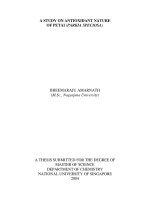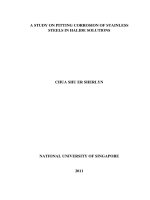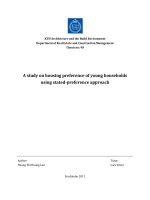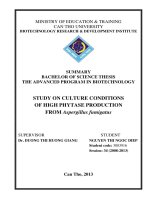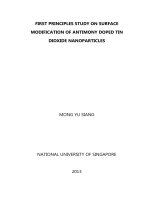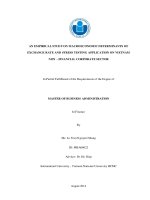Study on chemical modification of natural aminopolysaccharide use as absorbents to remove heavy metals in wastewater and give amethod with the optimal condition to get the best result.
Bạn đang xem bản rút gọn của tài liệu. Xem và tải ngay bản đầy đủ của tài liệu tại đây (2.6 MB, 40 trang )
1
ACKNOWLEDGEMENTS
Through this thesis, I would like to express the deepest appreciation to the
Deparment of Oil Refining and Petrochemistry for teaching me during 5 years at
HUMG. Especially, I wish to thank to my instructor, Dr. Nguyen Thi Linh for her
supervision, guidance and help throughout the thesis of my research work and for her
valuable comments on this thesis.
In additon, I would like to thank my friends in laboratory and my classmatesAdvanced Program K3 . They were always supporting and encouraging me with their
best .
Finally, during implementation the thesis, due to time constraint and my limited
knowledge, some flaws in the process are unvoidable. So I would like to receive the
help of lecturers for my thesis is more complete.
2
CONTENTS
Page
3
4
5
INTRODUCTION
In these day, the industry is growing rapidly and plays a important role in
economy. Beside the growing, it releases a lot of pollutants to enviroment, affects
directly human health and ecology. Ion heavy metals in wastewater of industry are like
Electroplating, Steel Processing, Metallurgy, Textile dyeing, Chemicals,...when
released into enviroment polluting the water source, influenced so much cause by high
toxicity and can accumulate in living body.
Heavy metal pollution is one of the most important enviroment problems for
the time being. However, treatments of heavy metals in wastewater in Viet Nam from
factorys still didn’t care too much. Because the factorys just are not too large
production scale, so they restrict investment to wastewater treatment systems.With the
lack of effective wastewater treatment systems, so concentration of heavy metals
releasing to enviroment will exceeds acceptance limit.
Consequently, Study to come up with a new method working more effective,
more environmentally friendly and cheaper is really necessary.According to these
requirements, we need proper methods that not only tackle heavy metals in wastewater
but also can restrict heavy metals’s harm to enviroment and human health. With the
consent of Oil & Gas Department and Dr.Nguyen Thi Linh, the thesis: ”Study on
chemical modification of natural aminopolysaccharide use as absorbents to remove
heavy metals in wastewater” is performed.
* Objectives:
Study on chemical modification of natural aminopolysaccharide use as
absorbents to remove heavy metals in wastewater and give a method with the optimal
condition to get the best result.
* Contents:
The thesis has 3 chapters:
Chapter 1: Literature review
Chapter 2: Experimental
Chapter 3: Results and discusstions.
6
CHAPTER 1. LITERATURE
REVIEW
Aminopolysaccharide
1.1. Introduction of aminopolysaccaride.
The majority of commercial polymers and ionexchange resins are derived from
petroleum-basedraw materials using processing chemistry that is notalways safe or
environmental friendly. Today, there is growing interest in developing natural lowcostaltematives to synthetic polymers. Chitin, found in the exoskeleton of shrimp
shells,the cuticles of insects, and the cells walls of fungi, is the most abundant
aminopolysaccharide (also known as aminopolysaccharide) in nature [1,2]. This lowcost material is a linear homopolymer composed of p(l-4)-linked N-acetyl
glucosamine. It is structurally similar to cellulose, but it is an aminopolymer and has
acetamide groupsat the C-2 positions in place of the hydroxyl groups.The presence of
these groups is highly advantageous providing distinctive absorption functions and
conducting modification reactions.
Figure 1.1 Structures of natural Aminopolysaccharide[3]
The raw polymer is only commercially extracted from marine shrimp shells
primarily because a large amount of waste is available as a by-product of food
processing. Chitin is extracted from shimp shells (shrimps, crabs, squids) by acid
treatment to dissolve the calcium carbonate CaCO 3 followed by alkaline extraction to
dissolve the proteins and by a decolorization step to obtain a colorless product
Since the biodegradation of chitin is very slow in waste shrimp shells,
accumulation of large quantities of discards from processing of shrimp shells has
become a major concern in the seafood processing industry. So, there is a need to
recycle these by-products. Their use for the treatment of wastewater from another
7
industry could be helpful not only to the environment in solving the solid waste
disposal problem, but also to the economy. However, chitin is an extremely insoluble
processes and uses of chitin, and so far, very few large-scale industrial uses have been
found. More important than chitin is its derivative, aminopolysaccharide.
Partial deacetylation of chitin results in the production of aminopolysaccharide
which is aminopolysaccharide composed by polymers of glucosamine and N-acetyl
glucosamine. The ‘‘aminopolysaccharide label’’ generally corresponds to polymers
with less than 25% acetyl content. The fully deacetylated product is rarely obtained
due to the risks of side reactions and chain depolymerization. Copolymers with various
extents of deacetylation and grades are now commercially available.
Aminopolysaccharide and chitin are of commercial interest due to their high
percentage of nitrogen compared to synthetically substituted cellulose.
Aminopolysaccharide is soluble in acid solutions and is chemically more versatile than
chitin or cellulose. The main reasons for this are undoubtedly its appealing in trinsic
properties such as biodegradability, biocompatibility, film-forming ability,
bioadhesivity, polyfunctionality, hydrophilicity and absorption properties Most of the
properties of aminopolysaccharide can be related to its cationic nature [1], which is
unique among abundant polysaccharides and natural polymers. These numerous
properties lead to the recognition of this polyamine as a promising raw material for
absorption purposes.
Demineralization
Deacetylation
Waste Shrimp Shells ────────> Chitin ──────────> Aminopolysaccharide
Deproteinization
Decoloration
1.2. Structure,
physical, chemical, biological properties of aminopolysaccharide
1.2.1. Structure of aminopolysaccharide[4]
Aminopolysaccharide is a partially deacetylated polymer obtained from the
alkaline deacetylation of chitin by changing N-acetyl to amin group at C2, a
biopolymer extracted from shrimp shells sources. Aminopolysaccharide exhibits a
variety of physico-chemical and biological properties resulting in numerous
applications in fields such as cosmetics, biomedical engineering, pharmaceuticals,
ophthalmology, biotechnology, agriculture, textiles, oenology, food processing and
nutrition.
8
Aminopolysaccharide established from 2-amino-2-deoxy-p-Dglucosamin unit,
contacted p-(l-4) glucozit.
Name: Poly(l -4)-2-amino-2-deoxy-β-D-glucose; poly( 1 -4)-2-amino-2-deoxyβ- D-glucopyranose
[ C6H11O4N]n
Maminopolysaccharide = (161,07)n
Chitin only has one practice group -OH, aminopolysaccharide has 2 practice
groups -OH,-NH2, so aminopolysaccharide is easier to take part in chemical reacti n
than chitin. Practical use of aminopolysaccharide has been mainly confined to the
unmodified forms. For a breakthrough in its utilization, chemical derivatization onto
polymer chains has been proposed to produce new materials. Derivatization is a key
point which will introduce the desired properties to enlarge the field of its potential
applications. Aminopolysaccharide has three types of reactive functional groups, an
amino group as well as both primary and secondary hydroxyl groups at the C-2, C-3
and C-6 positions. Its advantage over other polysaccharides is that its chemical
structure allows specific modifications without too many difficulties, especially, at the
C-2 position. These functional groups allow direct substitution reactions and chemical
modifications, yielding numerous useful materials for different domains of application.
The most commonly used chemical activations are carboxymethylation, acetylation
and grafting. The variety of groups which can be attached to the polymer is almost
unlimited.
9
Figure 1.2 Some compounds of Aminopolysaccharide and Chitin[6]
1.2.2. Physical and chemical properties of aminopolysaccharide [7]
• Linear aminopolysaccharide with high nitrogen content.
• RigidD-glucosamine structure; high crystallinity; hydrophilicity.
• Capacity to form hydrogen bonds intermolecularly; highviscosity.
• Weak base; the deprotonated amino group acts a powerfulnucleophile.
• Insoluble in water and organic solvents; soluble in dilute aqueous
acidicsolutions as acetic acid 2%, formic acid, lactic acid.
• Numerous reactive groups for chemical activation and crosslinking.
• Forms salts with organic and inorganic acids.
• Chelating and complexing properties.
• Ionic conductivit.
• Polyelectrolytes (at acidic pH).
• Cationic biopolymer with highcharge density (one positive charge per
glucosamineresidue).
• Flocculating agent; interacts withnegatively charged molecules.
• Entrapment and absorption properties; filtration and separation.
• Film-forming ability; adhesivity.
• Materials for isolation of biomolecules.
10
1.2.3. Biological properties [7]
Biocompatibility
• Non-toxic.
• Biodegradable.
• Adsorbable
Bioactivity
• Antimicrobial activity (fungi,bacteria, viruses).
• Antacid, antiulcer, and antitumoral properties.
• Blood anticoagulants.
• Hypolipidemic activity.
• Bioadhesive.
1.3. Applications
of aminopolysaccharide [7]
The potential industrial use of aminopolysaccharide is widely recognized. This
versatile material is used in biomedical engineering, pharmacy, dentistry,
ophthalmology, biotechnology, chemistry, cosmetics, textile, pulp and paper, oenology,
food industry, agriculture and photography.
Agriculture
• Protection of plants.
• Increase of crop yields (reduces the growth of phytopathogenic fungi).
• Seed and fertilizer coating; soil treatment Biomedical engineering.
• Biological activities (antifungal, antimicrobial, antiinfectious); antitumor
agent.
• Hemostatic effects; enhances blood coagulation.
• Promotes tissue growth; stimulates cell proliferation; artificial skin.
• Sutures/bandages.
• Ophthalmology, contact lenses.
Biotechnology
• Enzyme and cell immobilization.
• Cell-stimulating materials.
• Matrix for affinity chromatography or membranes.
• Chemical industry
• Water purification (metal chelation); water engineering (flocculation,
filtration, absorption); sludge treatment.
• Reverse osmosis, filtration membranes; gasseparation.
• Production ofbiodegradable packagingfilms.
• Catalysis.
11
Cosmetics and toiletries
• Hair spray, lotion; hand and body creams;shampoo, moisturizer.
• Food industry
• Diet foods and dietary fiber;hypocholesteroiemic activity (bindscholesterol,
fatty acids andmono glycerides).
• Preservation of foods from microbialdeterioration.
• Bioconversion for the production of valueadded food products.
• Recovery of waste material from foodprocessing discards.
• Clarification and deacidification of fruitjuices and beverages.
• Emulsifying agent; colour stabilization.
• Animal feed additive Pharmaceutics
• Controlled drug delivery carriers.
• Microcapsules (forming gels and capsules with anionic polymers).
• Dermatological products (treats acne).
Others
• Textiles (anti-bacterial properties).
• Pulp and paper (wet strength).
• Enology (clarification, deacidification).
• Dentistry (dental implants).
• Photography (paper).
1.4. Modification
of amonipolysaccharide[8]
1.4.1. Physical modification
The efficiency of absorption depends on physicochemical properties, mainly
surface area, porosity and particle size of adsorbents. Chitosan has a very low specific
area ranging between 2 and 30 m 2 g−1 whereas most commercial activated carbons
range between 800 and 1500 m2 g−1. Chitosan based material are used in different fields
of application in the form of powder, flakes and foremost as gels: beads, membranes,
sponge, fibers, hollow fibers, etc. Flake and power forms of chitosan are not suitable to
be used as adsorbents due to their low surface area and no porosity. Chitosan flakes
modified into beads are essential for the enhancement of absorption performance.
There are many studies describing the preparation of chitosan gels. Manufacturing of
gel beads allows an expansion of the polymer network improving access to internal
sorption sites and enhancing diffusion mechanisms.
1.4.2. Chemical modification
The chemical modification of chitosan is of interest as the modification would
not change the fundamental skeleton of chitosan but bring new or improved properties.
A great number of chitosan derivatives have been obtained with the aim of adsorbing
metal ions by grafting new functional groups on the chitosan backbone. The new
12
functional groups are incorporated to increase the density of sorption sites, to change
the pH range for metal sorption and to change the sorption sites in order to increase
sorption selectivity for the target metal. The chemical modification affords a wide
range of derivatives with modified properties for specific and use applications in
diversified areas mainly of pharmaceutical, biomedical and biotechnological fields.
1.5. Heavy
Metal in Wastewater[9]
1.5.1. Heavy Metal in Wastewater
Heavy metal is metals that has the density greater than 5mg/cm 3. Metals exist in
wastewater affecting human health and living bodies such as : Zn, Cu, Pb, Cd, Hg, Ni,
Cr, As,... Wastewater contains heavy metals is mainly released into enviroment cause
by industrial productive processes, mining process, refining ore, metals,... Moreover,
heavy metal compounds are widely used in industrial processes such as coloring and
dyeing, in tanning, rubber, textile and paper products, ... is a major source of heavy
metal pollution in water. There is also the existence of heavy metals in domestic
sewage by agents in cosmetics used to make-up, wash face ... and some chemicals used
in agriculture also cause this pollution.
Ions of heavy metals in water often combine with other components to move to
a more stable state and often hydrated to form shells that made by water molecules to
help protect it with non-water molecules around to return to a more stable state. This
hydrating shell is usually a sphere which has the metal ion is centered, the water
molecules that surround it are called the shell. The molecules that are closest to the
metal ions are most likely to interact with the strongest metal ions, the next ones being
weaker, and at some distance there will be no interaction.
Hydration process can be considered as a creating complex process with the
central are metal ions and ligands being water molecules. Usually, the number of
coordinates of most metals is 6.
Metallic ions carry a positive charge, so under the effect of electrostatic
repulsion, the hydrogen atoms of water molecules closing to the metal ions are ejected,
so the water molecules closing to the water molecules have higher acidic metal ions
(higher yields of protons) than water molecules outside the solution. The process of
ceding this proton has formed hydroxide complex, oxo or metal oxo hydroxide such as
hydroxide, oxide or oxide hydroxide mixtures. This process is called hydrolysis of
metal, metal ions with water.
13
1.5.2. Effect of some heavy metals on living body and human
1.5.2.1. Coppper(Cu)
* Source:
The main waste source of copper in industrial waste water is the wastewater
from the process of plating and wastewater from the washing and soaking process in
the tanks containing copper.Copper and brass tanks are often subjected to strong acids,
in their containment processes, containing solutions, which oxidize copper into the
solution. In copper plating processes, copper is used as the main material or as a
coating for metals such as gold, silver,...Copper in wastewater usually exists in the
2+
form of: Cu salts such as CuCl2, CuSO4... or exist as complex salts. For example,
when copper is combined with NaOH it produces: Na2[Cu(OH)4][10].
* Toxicity:
When the copper content in the human body is 10 g/kg (can be fatal), the dose
of 60-100 mg/kg cause of vomiting. For fish, when the concentration of Cu was 0.002
mg/l, 50% of the fish died. With cyanobacteria, when the concentration of Cu is 0.01
mg/l, it died. For plants, when the concentration of Cu is 0.1 mg/l was toxic[10]
* Concentration limit allowed[10][11]:
With drinking water and reservoir: 0.02-1.5 mg/l and depends on country standards.
Agricultural irrigation water: 0.2 mg/l, particularly for very poor soil, can use water
up to 5 mg/l for short time.
In industrial wastewater according to Vietnam Quality Standards Institute-59452005: 2mg/l
1.5.2.2. Lead(Pb)
* Source:
The main source of lead is wastewater from lead ore mining such as lead
sulphide (PbS), lead carbonate (PbCO3) and lead sulphate (PbSO4) ..., refining lead,
battery manufacture using lead electrodes, using leaded gasoline, steel, pesticides using
lead ...[10]
* Toxicity:
When the lead concentration in drinking water is 0.042-1.0 mg/l, symptoms of
chronic poisoning in humans occur. In irrigation water, if the lead concentrations are
greater than 5 mg/l, plants are poisoned [11] .
* Concentration limit allowed:
14
PTWI standard = 0.025-0.05 mg Pb/kg body weight/week. The maximum
allowed concentration of lead in drinking water of WHO is 0.05 mg/l. The allowed
concentration of lead in domestic water of Vietnam is 0.05 mg/l [8], [10].
In industrial wastewater according to Vietnam Quality Standards Institute-59452005: 0.5mg/l.
1.5.2.3. Crom(Cr)
* Source:
The main source of chromium is wastewater from coloration, electroplating, and
electroplating. In plating processes in the automotive industry, the automotive industry
produces the most chromium-plated products. The main source of chromium
compounds is the chromium that is used in the coating process [10].
* Toxicity:
Chromium metal is a non-toxic substance, only chromium compounds in the
3+
6+
form of Cr , Cr ions are toxic. In water, chromium occurs primarily in the form of
3+
6+
Cr , Cr . When the concentration exceeds the allowable dosage going into the human
body, it will cause harm: low toxic chromium poisoning the person will feel metal
taste, chills, muscle pain, chrome accumulates in the liver and kidneys will damage the
liver and kidneys and other organs[11].
* Concentration limit allowed:
According to WHO standards, the allowed concentration of chromium in
drinking water is 0.05 mg/l. In Vietnam, the allowed chromium concentration in
domestic water is 0.05 mg/l. According to Vietnam Quality Standards Institute-59452005, the allowed chromium (III) in industrial wastewater : 1mg / l [11].
1.5.2.4. Cadimi(Cd)
* Source:
Industrial activities are the main source for the generation of cadmiumcontaining wastes: metallurgy, plating, ore mining, electronics, batteries, batteries,
refining, burning coal and solid wastes, mechanical operations using cadmium [10].
* Toxicity:
Cadimi penetrates the body through the respiratory, eating and drinking. In high
concentration of Cd can cause anemia, kidney failure and bone marrow damage.
Concentration of Cd cause nephrotoxic effects is roughly : 0.2 mg / l [11].
* Concentration limit allowed:
15
TWI standard = 0.025-0.05 mg Cd/kg body weight/wk. The WHO standard for
maximum concentration in drinking water is 0.005 mg/l. The Vietnamese standard
allows the concentration of cadmium in domestic water to be 0.005 mg/l. According to
Vietnam Quality Standards Institute-5945-2005, the allowed concentration in industrial
wastewater: 0.01 mg/l [10], [12].
1.6. Some
general methods in treatment heavy metals
1.6.1. Precipitation [12][13]
Heavy metal treatment by precipitation is the most common and popular method
in Vietnam today. With the advantages of being inexpensive, the ability to process
multiple metals in the wastewater at the same time and the efficient handling of heavy
metals is acceptable, this method is the number one choice for industrial plants in
Vietnam.
* Mechanical Method:
Mn+ + Am- = MmAn↓(precipitation)
m
n
[ M] . [A] > Tt MA
A
: Precipitating agent
Tt : solubility)
In this method, it is possible to use many agents to precipitate with metals such
22as: S , SO4 , PO4 , Cl- , OH ... but just S2-, OH- is used the most because it can
3precipitate with most metals, and ions PO 4 , SO4 , Cl- ... only precipitate with certain
metal ions so that they are only used when the wastewater contains monometallic or a
few certain metals.
n+
(M : Metal ion
m-
* Precipitation process:
After transferring the metals to easier handle and less toxic form, we proceed to
the precipitation method.
• OH precipitation:
At a certain pH (pH> 7) the metals combined with OH- form the precipitated
metal hydroxide.
2+
-
Cu + 2OH = Cu(OH)2↓
2+
Cd + 2OH = Cd(OH)2↓
2+
Ni + 2OH = Ni (OH)2↓
3+
Cr + 3OH = Cr (OH)3↓
16
3+
-
Fe + 3OH = Fe (OH)3↓
2+
Zn +2OH = Zn (OH)2↓
n+].[OH-]n > T
Principle of creating precipitation is [M
t M(OH)
Table 1.1 pH at the starting point of the precipitation of the metals
Ion
Fe3+
Cu2+
Cr2+
Fe2+
Pb2+
Ni2+
pH
2,0
5,3
5,3
5,5
6,0
6,7
Ion
Cd2+
Co2+
Zn2+
Mg2+
Mn2+
Ag+
pH
6,7
6,9
7,0
7,3
8,5
9,0
pH in the process must ensure that the process can precipitate easily and
conveniently. To make pH > 7 we can use alkaline substances such as NaOH, KOH,
Ca(OH)2 .... For economy, people often use Ca(OH)2 because it is cheap, easy to find
and get good effect. However, this method is often ineffective for large precipitated
metals, especially for complex metals at high pH. This is one of the biggest drawbacks
of the OH-precipitation method. Table 1.1 only shows the minimum pH possible to
precipitate heavy metals. At this pH, the precipitation of the metals is not maximized.
•
Sulfite precipitation:
Cu2+ + S2-= CuS↓
Cd2+ + S2- = CdS↓
Ni2+ + S2- = NiS ↓
Pb2+ + S2- = PbS ↓
Zn2+ + S2- = ZnS↓
The same with OH precipitation for precipitation, [Mn+]2.[S2-]n > Tt MSn/2 (if n
divided by 2)
17
n+]2.[S]n >T
If not, [M
tM2Sn
* Pros and Cons of the method:
• Pros:
Simple, cheap, easy to use and find materials.
Water quality after treatment meets Vietnam Quality Standards Institute-59452005 standards.
Wastewater can be treated in large scale factories and can handle many metals at
the same time.
• Cons:
With high concentration of metal, this method is not thoroughly processed, can
creat sludge waste metal and transportation costs, buried when the sludge to
process.
When making OH precipitation, it is difficult to adjust the pH for wastewater
containing amphoteric heavy metals such as Zn.
1.6.2. Absorption [14][15]
The absorption method is one of the most common methods of treating
wastewater in general and wastewater containing heavy metals in particular. The
method is used when processing waste water containing toxic levels are not high. The
process of heavy metal absorption occurs between the liquid surface of the heavy metal
solution and the solid surface of the adsorbent.
Currently, many materials have been found to absorb heavy metals such as
activated carbon, peat, inorganic materials such as iron oxide, manganese oxide, fly
ash, coal slag,...
* Mechanical Method:
Absorption is the process of absorbing evaporated gases or solutes in a liquid
onto a porous solid surface. There are usually two types of absorption:
• Physical absorption:
The physical absorption process for adsorbents and heavy metal ions in water
often occurs by electrostatic attraction between these metal ions and the absorption
sites on the adsorbent surface. This connection is usually weak and unstable. However,
because of weak bonding, the absorption process to recycle the adsorbable material and
recover the metals is advantageous
• Chemical absorption:
Absorption of chemistry occurs due to the reaction to form chemical bonds
between heavy metal ions and functional groups of absorption site. Normally, the
18
heavy metal ions react complexation with functional groups in absorbents. This
bonding is usually very durable and difficult to break, so it is difficult for the
deabsorption process.
After the absorption to treat the toxins in water in general and heavy metals in
particular, it is often carried out absorption for reconstitution, recycling (for valuable
adsorbents, and must have a size that is large enough to reproduce) the adsorbent and
in many cases the precious constituents can be recovered.
1.6.3. Ion exchange [14][15]
Ion exchange method is one of the most common methods for treating heavy
metal ions in wastewater such as Ni2+, Fe2+, Fe3+, Cu2+, Zn2+ ... The method is quite
effective in treating heavy metals, especially able to effectively recover some precious
metals. Ion exchange process takes place between the two liquid-solid phases, the ions
in the solution and the ions in the solid phase.
Ion exchangers are very rich and varied, depending on the processing
requirements and conditions of use that people can choose from. Ion exchangers have
inorganic sources such as: mineral metal, clay, silica, pecmutite, oxide & hydroxide of
some metals such as chromium, aluminum, zirconium and inorganic sources such as:
humic acid of humus and coal ...
* Mechanical Method:
In fact, the ion exchange method is a part of the absorption method, but the
absorption process is accompanied by the ion exchange between the adsorbent and the
ion of the solution. It can be said that ion exchange is a process in which ions on the
surface of solids exchanged with ions have the same electric charge in solution when
they contact with each other. These are called ionic (ion exchange) substances, which
are completely insoluble in water.
• Cation exchange:
RA + B+ = RB + A+
For metal exchange, B + is metal ions such as: Ni2+, Cu2+, Zn2+, Cr3+,
Fe2+ ...
• Ation exchange:
RA + B- = RB + AFor heavy metal exchange, B- can be: Cr2O72-, MnO42- ....
19
When heavy metals are contacted to ion exchanger, ion exchange process occurs
between the solution and the ion exchanger.
20
CHAPTER 2. EXPERIMENTAL
2.1. Materials
and Apparatus
2.1.1. Materials
• Shrimp shells
• Acid chlohydric , Sodium hydroxide
• Amonium persulfate, enzyme papain, copper sulfate
• Distilled water
2.1.2. Appartus
• Thermometer
• Three neck round bottom flask, erlenmeyer flask, condenser
• Measuring cylinder & beaker
• Magnetic Stirer & stirring bar
2.2. Amonipolysacharide
synthesis process.
We did this process in 2 methods
* Method 1: Use emzyme papain
Step 1:Wash the shrimp shells and dry in the oven.
Figure 2.3 Shrimp shells after washing and drying
Step 2: Demineralization
Weigh 40 g dried shimp shells and put in the cup of 1 litre, then put slowly 200
ml of 10% HC1 into immersed shimp shells. It has phenomena of strong foaming, so
reaction occurs (check the pH = 1-2), immerse it for about 12 hours (ovemight in room
temperatures), stirring occasionally so that the reaction occurs rapidly (until no foam,
gas escapes, pH still acid).
21
After 12 hours, removing the shimp shells and washing with water to pH = 7,
then washing with distilled water. At this time, shimp shells are light pink, soft by
removing most inorganic impurities.
Figure 2.4 Shrimp shells after treating with HCl(enzyme method)
Step 3 : Deproteinization
Dissolve the enzyme papain in water with a ratio of 0.3 g of enzyme in 100 ml
distilled water.
+ Mix shrimp shells with enzyme solution so that the shrimp shells is submerged in
emzyme solution.
+ Leave in the oven at 60°C for 2.5 hours.
+ After 2.5h, we wash, dry and obtain Chitin.
Figure 2.5 Chitin (enzyme method)
Step 4: Deacetylation (transfer chitin to aminopolysaccharide)
22
Weigh 10g of chitin into a 500ml flask. Add 50% NaOH, set up condenser to
avoid evaporation when boiling. Boil for 4.5 hours at 100°C, then wash until pH 7. The
product we got is aminopolysaccharide (APS).
Figure 2.6 Aminopolysaccharide(enzyme method)
* Method 2 : Use microwave oven
Step 1: Wash the shrimp shells and dry in the oven.
Figure 2.7 Shrimp shells afer washing and drying
Step 2: Demineralization
Soak the shrimp shells in a 3M HCl solution with a solid / liquid ratio = 1/10.
Place the sample in the microwave oven at 500W for 8 minutes. Take samples from the
oven and filter, rinse with distilled water until pH =7.
23
Figure 2.8 Shrimp shells after treating with HCl(microwave method)
Step 3: Deproteinization
After demineralization, shrimp shells was soaked in 10% NaOH solution with a
solid / liquid ratio = 1/10. Take samples into the microwave oven, process at different
heat levels:
- 160W for 5 minutes.
- 350W in 3 minutes.
Then take the sample into the filter, rinse with distilled water (pH = 7), we obtain
chitin.
Figure 2.9 Chitin (microwave method)
Step 4: Deacetylation (transfer chitin to aminopolysaccharide)
24
The chitin was soaked in 50% NaOH solution with a solid / liquid ratio = 1/20.
After that, the sample was placed into a microwave oven, reacting at 350W for 8
minutes.
After the reaction, the sample was removed by filtration with distilled water (pH = 7),
we obtain aminopolysaccharide.
Figure 2.10 Aminopolysaccharide (microwave method)
2.2.1. General Process( diagram)
25
2.2.2. Deacetylation process
The reaction produce amino polysaccharide by deacetylation chitin[16]
By deacetylation chitin, -NH3COCH3 transform to – NH2, remove acetylCH3CH group, transform to natri salt CH3COONa.
2.3. Modification of aminopolysaccharide (APS) by crosslinking with
ammoniumpersulfate (AMS)
• Process:
Weigh 2 grams of aminopolysaccharide(milled) into 150ml of distilled water
and stir at 600rpm, heat to 50-60°C. When reached temperature, we syringe each drop
of the solution containing 1g of ammonium persulfate. Stir continuously for 1 hour.
After the reaction, the product filtered through the filter paper obtained brown yellow
colored product. We dry product at 80 °C until totally dry.
2.2.3. Investigation on effect of reaction temperature
Temperature is an important element in combined reaction of compounds. The
difference between temperatures may occur differently reactions if reactions occur in
the mixture.
In the process of modification described above, to survey the effect of
temperature, we keep the conditions as the ratio of materials, stirring speed, amount of
initiator, stirring time. Temperature change at 4 levels:50°C, 60°C, 70°C, 80°C. The
results obtained carry out IR spectral analysis, determining deacetylation after
modification. So, we can derives the ability of modification by temperature.
2.2.4. Investigation on effect of material ratio
The study should provide the most appropriate initial dosage for modification
process.



